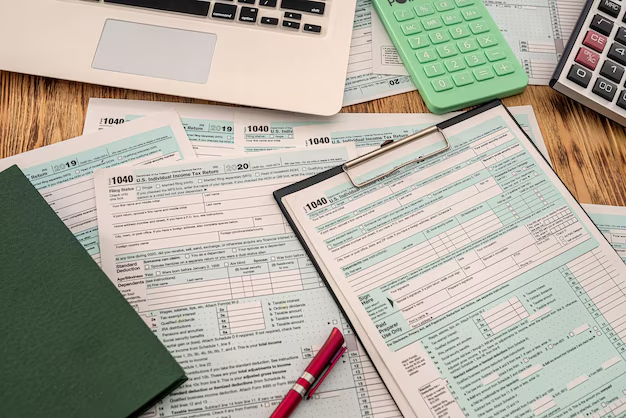Understanding the IRS Form 1040: Your Ultimate Guide
Every year, millions of Americans face the task of filing their taxes, and one term continually emerges in this financial ritual: Form 1040. Understanding the ins and outs of this essential IRS document can alleviate stress and ensure you are in compliance with federal tax laws. Let's dive deeper into the world of the IRS Form 1040, exploring what it is, how it functions, and the importance of the sections it contains.
🌟 Why Is Form 1040 Important?
Form 1040 serves as the primary tool for individuals in the United States to report their annual income to the Internal Revenue Service (IRS). Accurately completing this form is crucial because it determines the amount of income tax owed to the federal government or the refund you might receive. Whether you're self-employed, employed by a business, or receiving income from investments or other sources, Form 1040 aggregates all relevant financial information.
📝 The Basics of IRS Form 1040
What is Form 1040?
Form 1040, also known as the "U.S. Individual Income Tax Return," is a tax form used for personal federal tax returns. It's essential for declaring your taxable income, claiming deductions you qualify for, and computing tax liabilities.
Who Needs to File a Form 1040?
Anyone who earns a certain amount of income is required by the IRS to file a Form 1040. This includes:
- Single filers earning above a specified threshold
- Married couples filing jointly or separately
- Heads of household
- Self-employed individuals
The IRS provides guidelines on specific income thresholds and qualifications which determine the necessity to file.
Forms Similar to 1040
Historically, there have been variations like the 1040-EZ and 1040-A, but these have been phased out. Today’s Form 1040 includes elements from these simplified forms, allowing all taxpayers to file the same basic document with potential additional schedules if necessary.
🗂️ Components of Form 1040
Understanding each section of Form 1040 can make the filing process smoother. Here's a closer look at the core components:
Personal Information
The form begins with personal details such as your name, Social Security number, and filing status. Correct information here ensures accurate processing and secure accounting of your taxes.
Income Section
This section encompasses a wide variety of income sources, ranging from wages and salaries to dividends and alimony. It's critical to report all sources accurately to avoid discrepancies.
Adjustments to Income
Also known as "above-the-line deductions," these include deductions for educator expenses, student loan interest, and alimony payments, among others. These adjustments can reduce your total taxable income, potentially lowering your tax liability.
Tax Computation
After calculating your adjusted gross income (AGI), the tax computation section helps determine your tax responsibility by considering any credits or tax deductions to minimize that liability.
Refunds and Payments
Here, you'll calculate the amount of tax you've already paid through withholding or estimated payments, determining whether you owe more tax or are set to receive a refund.
🔍 Key Considerations and Schedules
While Form 1040 covers the basics, you may need additional schedules to account for particular circumstances and sources of income.
Schedule 1: Additional Income and Adjustments to Income
This is for reporting additional income such as capital gains, unemployment, and gambling winnings, as well as specific adjustments to income that don't appear on the main form.
Schedule 2: Additional Taxes
For those subject to extra taxes like the AMT (Alternative Minimum Tax) or other specific tax obligations.
Schedule 3: Additional Credits and Payments
For claiming extra credits unavailable directly via Form 1040, like residential energy credits or excess Social Security withheld.
Practical Filing Tips
- Double-check entries: Mistakes, especially in figures and Social Security numbers, can delay processing.
- Mind the deadlines: Missing the filing deadline can result in penalties. The typical deadline is April 15th.
- Consider electronic filing: E-filing is often more secure and results in faster processing and refunds.
💡 Simplifying the Process: Tips for Filing
Navigating through tax forms like the 1040 can seem daunting, but it doesn't have to be.
Consider Professional Help
If your financial situation is complex, involving multiple income streams, investments, or significant deductions, hiring a tax professional might be wise.
Utilize Tax Software
Many choose tax software for its ease of use, step-by-step guidance, and electronic submission features, which streamline the filing process significantly.
Collect All Necessary Documents
Before diving in, gather all relevant documentation, including W-2s, 1099s, and any paperwork regarding deductions and credits.
✨ Quick Reference: Key Points About Form 1040
Here’s a concise summary with tips and key takeaways to keep you on track:
- 👨👩👧👦 Who Files: Anyone earning above the IRS-defined threshold.
- ✍️ What It Details: Personal info, income, deductions, tax credits, payments, and refunds.
- 📆 Timeline: File annually by April 15th; extensions available.
- 🔑 Essentials: Accurate income reporting, understanding deductions, using the correct form variations.
- 📑 Schedules: Reflect complex financial scenarios beyond the base form.
- 🖥️ Filing Methods: Consider both e-filing and traditional paper forms based on comfort and complexity.
By using these insights, you should have a thorough understanding of Form 1040, ready to approach tax season with confidence and clarity. Always remember, being organized, informed, and timely in your approach is the key to a hassle-free tax experience.
